Bregenzer Festspiele
Bregenzer Festspiele (German pronunciation: [ˌbreːɡɛntsɐ ˈfɛst.ʃpiːlə]; Bregenz Festival) is a performing arts festival which is held every July and August in Bregenz in Vorarlberg (Austria). It features a large floating stage which is situated on Lake Constance.[4]
| Bregenzer Festspiele | |
|---|---|
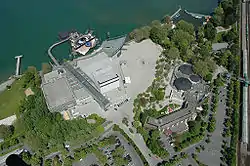 Aerial view of the stage of the Bregenzer Festspiele at and on Lake Constance (2008) | |
| Status | active |
| Genre | opera, musical, performance |
| Venue | Seebühne (floating stage), Festspielhaus (amongst others) |
| Location(s) | Bregenz, Vorarlberg |
| Country | Austria |
| Inaugurated | 1946[1] |
| Next event | 2024[2] |
| Capacity | 11,735 seats[3] |
| Budget | 22 million € per year[3] |
| Sponsor | public subsidies: 6,94 million €, funds from sponsors and donors: 1,3 million €[3] |
| Website | bregenzerfestspiele |
History
The Festival became an international event in its first year 1946, one year after World War II. People from Germany, Switzerland and France came to the festival. Two stages were created out of floating barges. One barge for the Vienna Symphony Orchestra and the other barge for carrying stage structures.
The Vienna Symphony Orchestra is the biggest contributor to the Festival. This orchestra has a performance spot every year since the beginning of the festival. They have their own stage area and other venues used thorough out the festival. Every year the orchestra has a different conductor for each piece because it is considered the conductors performance. Kornmarktplatz, vorarlberg museum is the venture they are using for the 2016 Festival.
In 2001, the festival created a handful of contemporary arts events to go along with their usual performances. These events were a new collaboration with the Kunsthaus Bregenz that revolved around the theme of "America of the 20th century", and The Art of Our Times program, also known as KAZ, that brought together contemporary theatre with Workshop Theatre while collaborating with Hamburg's Thalia Theater. Other add-ons that the festival created for more variety and entertainment are the Children's Festival, the opera and band workshops, and family and school-group concerts.[5]
From December 2003 until 2014, David Pountney has been the artistic director of the festival.[6]
Over April and May 2008, scenes for the 22nd James Bond film Quantum of Solace were filmed on the Seebühne during a performance of Tosca[7] and in June 2008 the German broadcasting corporation ZDF hosted its 2008 European Football Championship live broadcast studio on the floating stage.
In 2010, the festival offered about 100 performances that drew an audience of close to 200,000.
2015 was the first year for Elisabeth Sobotka as artistic director. She started with 80 events and by end of August 2015, further founded the Opera Studio with the goal "to help young singers with their professional and personal development in a highly professional environment and also to create a staging that the audience will really enjoy".[8]
The season of year drew an audience of approx. 257,000. Carmen proved to be very popular and was mostly fully booked with a total audience number of 193,642 people, already including the dress rehearsal and crossculture night.[9] In 2018, the Bregenz Festival broke its own record: With 270,000 visitors in only 5 weeks, the festival attained a new attendance record. It attracted 400,000 people in total when the programme featured Bizet's Carmen in 2017 and 2018.[10]
The Bregenz Festival continues to show a series of popular Puccini works. La Bohème was the first Puccini performance in 2001/02, followed by Tosca in 2007/08 and most recently Turandot in 2015 and 2016, Madame Butterfly in 2021/22 will be the fourth opera by the Italian composer to be performed in Bregenz.
The festival offers guided tours from May to August.[11]
The Bregenzer Festspiele had to cancel the 2020 festival due to the COVID-19 pandemic. The performances of Rigoletto and the opera Nero have been postponed to 2021.[12]
Venues
The festival presents a wide variety of musical and theatrical events in the following venues:
- Seebühne (or floating stage), with its 7,000 seat open-air amphitheatre, is the location for large-scale opera or musical performances on a stage over water on the shores of Lake Constance.
- Opera or musical productions on the floating stage generally tend to come from the popular operatic repertoire, but often are extravagantly original and innovative productions/ stagings, frequently using the waters of the lake as an extension of the stage. Recent productions have included Aida by Giuseppe Verdi in 2009 & 2010; Tosca by Giacomo Puccini in 2007–2008; Il trovatore by Giuseppe Verdi in 2005–2006; West Side Story by Leonard Bernstein in 2003-2004; La bohème by Giacomo Puccini in 2001–2002, and Ein Maskenball (Un ballo in maschera) by Giuseppe Verdi in 1999–2000.
- Festspielhaus presents performances of rarely performed opera and concerts.
- Werkstattbühne presents performances of contemporary theatre and opera.
- Theater am Kornmarkt presents operetta and drama performances.
- shed8/Theater Kosmos venue for drama and crossculture performances.
Plays performed
Throughout the seasons, the festival puts on many different performances; from operas to plays and orchestral pieces. The performances range in theme and story and many are performed in consecutive seasons. The full list of shows performed is as follows:[13]
Facts and figures
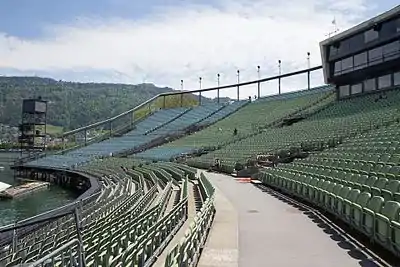
A visitor survey showed that the Lake Stage audience's origin is the following: 63 % Germany, 23 % Austria, 11 % Switzerland/Liechtenstein, 3 % other countries.(2019)[3]
The Bregenzer Festspiele has the following seating capacities:
- Lake Stage: 6,980
- Festspielhaus, Great Hall: 1,656
- Workshop Theatre: 1,563
- Lake Foyer: 168
- Lake Studio: 330
- Park Studio: 220
- Vorarlberger Landestheater: 502
- Kunsthaus Bregenz: 150
- Theater Kosmos: 166
This adds up to a total of 11,735 seats.[3]
Photo gallery
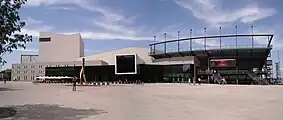 The Festspielhaus of the Bregenzer Festspiele
The Festspielhaus of the Bregenzer Festspiele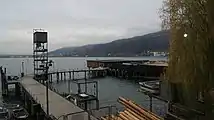 The floating stage in November 2018
The floating stage in November 2018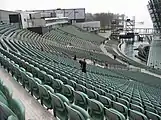 Seebühne (floating stage) stands for the 2003/2004 performances of West Side Story
Seebühne (floating stage) stands for the 2003/2004 performances of West Side Story Sculpture "Ready Maid" at the Bregenzer Festspiele
Sculpture "Ready Maid" at the Bregenzer Festspiele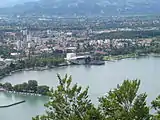 The floating stage from a distance
The floating stage from a distance.jpg.webp) Two masks from the performance of Zauberflöte at the Bregenz Festival 2014
Two masks from the performance of Zauberflöte at the Bregenz Festival 2014.jpg.webp) Backstage area of the floating stage
Backstage area of the floating stage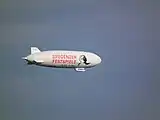 Bregenzer Festspiele zeppelin in May 2012
Bregenzer Festspiele zeppelin in May 2012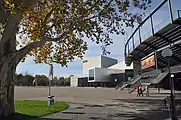 The Festspielhaus
The Festspielhaus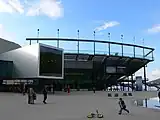 The Festspielhaus
The Festspielhaus.jpg.webp) Inside the Festspielhaus
Inside the Festspielhaus
References
- "History of the Bregenz Festival: Origin and genesis". Archived from the original on 14 June 2014. Retrieved 8 September 2020.
- "Cancellation Bregenz Festival 2020". Archived from the original on 13 August 2020. Retrieved 8 September 2020.
- "Facts and Figures – Bregenz Festival". Retrieved 11 July 2021.
- "Festivals in Austria". www.austria.info. Retrieved 28 February 2019.
- "HISTORY OF THE BREGENZ FESTIVAL". Archived from the original on 14 June 2014.
- "Bregenz Festival: the world's splashiest opera?". telegraph.co.uk. Retrieved 7 July 2015.
- "James Bond in the eye of Tosca". bregenzerfestspiele.com. Archived from the original on 8 July 2015. Retrieved 7 July 2015.
- "Bregenz Festival opens for 70th season | Bregenz Festival". pressefoyer.at. Retrieved 26 June 2018.
- "History of Bregenz Festival | Bregenz Festival". pressefoyer.at. Retrieved 26 June 2018.
- "Rekordbilanz für Bregenzer Festspiele". vorarlberg.orf.at (in German). 17 August 2018. Retrieved 28 February 2019.
- "Guided Tours | Bregenz Festival". bregenzerfestspiele.com. Archived from the original on 2 March 2021. Retrieved 28 February 2019.
- "Cancellation Bregenz Festival 2020 | Bregenz Festival". bregenzerfestspiele.com. Archived from the original on 13 August 2020. Retrieved 7 June 2020.
- "History of the Bregenz Festival | Bregenz Festival". bregenzerfestspiele.com. Archived from the original on 14 June 2014. Retrieved 14 August 2019.
- "Vorschau auf die Saison 2022 der Bregenzer Festspiele -" (in German). 10 June 2021. Archived from the original on 11 July 2021. Retrieved 11 July 2021.
- "Cancellation Bregenz Festival 2020 | Bregenz Festival". bregenzerfestspiele.com. Archived from the original on 13 August 2020. Retrieved 7 June 2020.